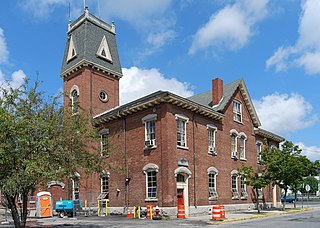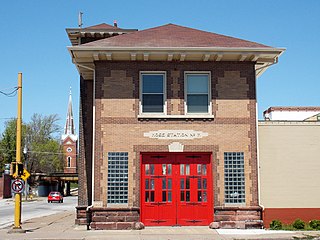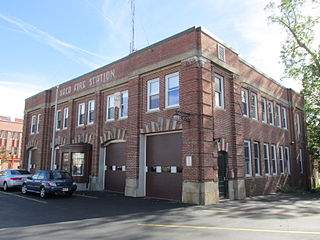
The building at 14 Maple Avenue in Windsor, Connecticut is a Former Fire Station of the town. It was built about 1882, and was the town's first purpose-built firehouse. Now converted to commercial use, it was listed on the National Register of Historic Places in 1988.

Fire Station Number 4 or Fire Station No. 4 is a historic fire station located at 474 Broadway in Pawtucket, Rhode Island. The building historically has also been called the Collyer Fire Station. The Queen Anne Style station was built in 1890. It is a 2 1⁄2-story, hip-roofed rectangular brick building with two brick wings and a bell tower. Constructed of red brick with sandstone trim and sandstone lintels and sills on the windows, the building has a foliate terracotta plaque bearing its name and date of construction. The fire station was closed as a firehouse in 1974, when the current Fire Station Number 4 on Cottage Street opened. The interior of the building was greatly modified to accommodate offices and meeting rooms by the time of its listing on the national register. In 2014, the building is being used by the Catholic Charities of Providence. Fire Station Number 4 was added to the National Register of Historic Places in 1983.

The Lake Street Fire Station is an historic fire station in Gardner, Massachusetts. Built in 1884 to house a school and a fire company, it served as a school for just a few years, and as a fire station until the 1980s. It is architecturally distinguished as a good local example of late Victorian architecture. The building was listed on the National Register of Historic Places in 1980, and included in the West Gardner Square Historic District in 1985.

The Central Fire Station is an historic fire station at Leonard and School Streets in Taunton, Massachusetts. Built in 1869, it is the third oldest fire station still in use in the country, and the oldest in the city. It is the oldest *continuously operated* fire station in the country, never having closed for any period of time. It houses Taunton's Engine 1, Ladder 3 and the Deputy Chief. It was listed on the National Register of Historic Places in 1984.

Quincy Point Fire Station is a historic fire station at 615 Washington Street in Quincy, Massachusetts. Built in 1941, it is the third firehouse to occupy the location, and is one of the city's finest examples of Colonial Revival architecture. It was listed on the National Register of Historic Places in 1994.

The Old Stonington High School is a historic school building at 25 Orchard Street in Stonington, Connecticut. It was built in 1888, and is a distinct and high quality local example of Second Empire architecture. The building was listed on the National Register of Historic Places in 1978; it has been converted to residential use. This building is not to be confused with the town's modern high school of the same name in Pawcatuck.

The Charter Oak Firehouse is a historic former fire station at 105 Hanover Street in Meriden, Connecticut. Built in 1876, it was the first firehouse built in Meriden, and is the oldest surviving municipal building in the city. The firehouse was listed on the National Register of Historic Places on March 17, 1994. It has been converted to offices.

The Tunxis Hose Firehouse is an historic firehouse at Lovely Street and Farmington Avenue in the center of Unionville, Connecticut. BUilt in 1893, it is a well-preserved example of a late 19th-century rural firehouse with Queen Anne Victorian features. The building was listed on the National Register of Historic Places on July 28, 1983. It presently houses a muster vehicle for Tunxis Hose Company No. 1, a local volunteer fire company.

The Engine Company 15 Fire Station is located at 8 Fairfield Avenue in Hartford, Connecticut. It was built in 1909, and is one of two surviving firehouses in the city which was built to stable horses. It was listed on the National Register of Historic Places on March 2, 1989. It presently houses Engine Company 15 and Ladder Company 2 of the Hartford Fire Department.

The former Torrington Fire Department Headquarters is a historic building located at 117 Water Street in Torrington, Connecticut. It is located immediately adjacent to the modern headquarters at number 111. Completed in 1901, it is an elegant example of Romanesque Revival architecture, and served as the city's main firehouse until 1980. The building was listed on the National Register of Historic Places on December 31, 1987.

Hook and Ladder No. 4, originally Truck No. 4, is a firehouse located at Delaware Avenue in Albany, New York, United States. It is an elaborate brick structure in the Dutch Colonial Revival architectural style, designed by Albany architect Marcus T. Reynolds, and completed in 1912. In 2001 it was listed on the National Register of Historic Places.

The Thomaston Opera House is a historic performance venue and the town hall of Thomaston, Connecticut. Located at 153 Main Street, it was built in 1883-85, and is a good local example of Romanesque architecture. The theater in the building has served as a performance and film venue since its construction. It was listed on the National Register of Historic Places in 1972. The opera house's principal tenant is now the Landmark Community Theatre.

The Central Fire Station is located in downtown Davenport, Iowa, United States and serves as the headquarters of the Davenport Fire Department, as well as the downtown fire station. Built from 1901 to 1902, the original building is the oldest active fire station west of the Mississippi River. It was individually listed on the National Register of Historic Places in 1982. In 2020 it was included as a contributing property in the Davenport Downtown Commercial Historic District.

The Hose Station No. 7 is located along a busy thoroughfare in a light industrial area of the west end of Davenport, Iowa, United States. It was listed on the National Register of Historic Places in 1983.

Putnam and Mellor Engine and Hose Company Firehouse was a historic fire station located at Port Chester, Westchester County, New York. It was built in 1888 and is a three-story, three bay wide, masonry building in the Queen Anne style. It is constructed of red brick with stone stringcourses and terra cotta decoration. It features a low hipped roof with decorative gable ends and a corner bell tower.

Portland Fire Station No. 7, located in southeast Portland in the U.S. state of Oregon, is a two-story structure listed on the National Register of Historic Places. Built in 1927, it was added to the register in 1989. It was the last of numerous Portland firehouses to be designed by fire chief and architect Lee Gray Holden, who died of a stroke while visiting the No. 7 firehouse in 1943. The building continued to be used by the city's Fire Department until the 1980s, when it was sold off and used as an automobile garage. It was acquired by a local developer in 2009, and was restored and remodeled for office and retail use.

The Former Saco Central Fire Station is a historic fire station at 14 Thornton Avenue in Saco, Maine. Built in 1939 with funding from the Public Works Administration, it was the city's first modern firehouse, designed to house motorized equipment, and outfitted with the latest technology. The building was listed on the National Register of Historic Places in 2013. The building housed the fire department until 2011, and has since been converted into a mixed-use residential and commercial property.

The W.H. Bradford Hook and Ladder Fire House is a historic fire station at 212 Stafford Street in Bennington, Vermont. Built in 1893-94, it served for over a century as a fire house for the city, and survived modernizations with much of its historic fabric intact. It has been converted into artist studios and living space. It was listed on the National Register of Historic Places in 1999.

The Sauk City Fire Station, begun in 1862, housed the city's early fire department, and served as a center of the community. Today it is one of the oldest fire stations in Wisconsin. It looks much like it did in 1870 - a gable-roofed building with a hose-drying tower. It was added to the National Register of Historic Places in 1999.





















